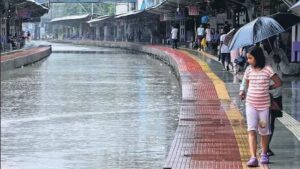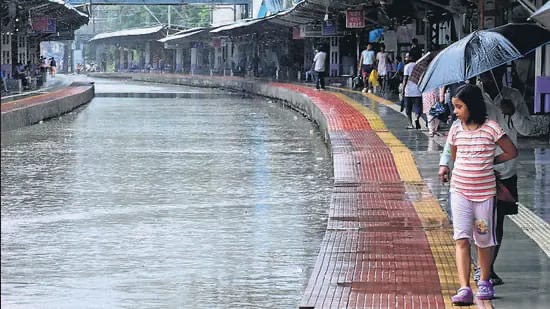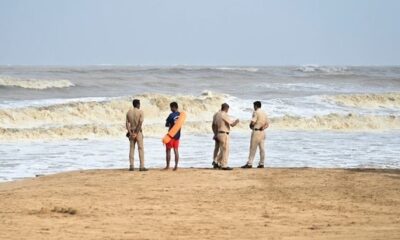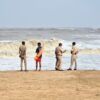Fury Mithi river paralyses Mumbai’s lifeline -trains come to grinding halt

For the rail authorities, the overflowing Mithi proved to be the pain point, as water flowed backwards onto the rail tracks and the roads running parallel to the tracks. The issue began on Tuesday morning when the rain intensified and the situation was exacerbated by the high tide of 3.74 metres
Reportedly, the Mithi roared like the river it once was rather than the discarded nullah turned over the decades, and on Tuesday, its turbulent force brought Mumbai’s lifeline, the local train network to a grinding halt.Trains on the Main and Harbour lines of Central Railway (CR)—on the Kurla, Sion, Matunga, Chunabhatti and Govandi stretches—ground to a halt for almost eight hours between 11.30 am and 7.30 pm. Western Railway (WR), meanwhile, limped along on the Mahim-Matunga Road-Dadar stretch albeit with delays.
For two days, the railway authorities fought off the water logging along the Dharavi nullah caused by the incessant rains, and managed to keep trains running.
But on August 19, they eventually faltered after Mumbai received a staggering 163-plus mm of rainfall between 8.30 am and 5.30 pm. Such was the impact of the downpour and overflowing Mithi river that over 800 train services on CR—45 percent of its 1,810 daily services—were cancelled, while WR cancelled 100 of its 1,406 services.
Nissan Magnite – SUV stance, city comfort, and great mileage.
The average delays ranged from 20 to 45 minutes through the day on sections where trains were operational. At least 16 long-distance trains were rescheduled and 14 were cancelled, while five were short-terminated at Pune, Nashik and Panvel. On the Western line, the Vasai-Virar belt was also problematic due to heavy water logging, which led to the slowing down of train services.
For the rail authorities, the overflowing Mithi proved to be the pain point, as water flowed backwards onto the rail tracks and the roads running parallel to the tracks. The issue began on Tuesday morning when the rain intensified and the situation was exacerbated by the high tide of 3.74 metres.
“The main reason for the disruption in train services was the overflowing Mithi which crossed the danger mark at around 9.30 am,” said a senior Central Railway official. “The floodgates of the river at Kurla were shut at this time by the BMC. This, along with high tide, threw water back onto the rail lines. All the pumps that we had installed were redundant, as there was no place to pump out the water. There was 11 inches of water on sections of Sion-Kurla and 19 inches on Kurla-Chunabhatti. The normal permissible level is 6 inches for local trains and 4 inches for long-distance ones.”
In the first half of the day, the Mithi touched 3.8 metres and marginally reduced to 3.6 metres by 5.30 pm. The railway authorities go into alert mode when water levels touch 2.7 metres. “The water retracted on the rail tracks in and around Sion, Kurla, Govandi and Chunabhatti stations,” said another CR official. “This led to it reaching 16 to 17 inches above the rail tracks, which is a safety issue. It is not advisable to run either local or mail express trains on such waterlogged tracks.”
The Mithi surpassed the railway’s permissible levels of 2.7 metres by 1,100 mm, which led to water logging. The river flows via Dharavi nullah through a 1.8-metre-wide culvert that passes perpendicular to the rail tracks and roads. At around 10.20 am, the intensity of the rain increased, which affected the Kurla-Mankhurd stretch. By 11.20 am, the CR authorities were forced to partially suspend train services between Kurla and Chunabhatti and in another 15 to 20 minutes, the Slow and Fast lines on the Kurla-Sion stretch were also suspended. This completely cut off South Mumbai from the eastern suburbs.
“I left home at 6.30 am and reached office at 8.30 am,” said Heena Mehra, a banker who lives at Badlapur and works at BKC. “The journey was smooth and there were no issues. I There were no auto rickshaws and severe water logging but thankfully the civic authorities and local people helped us reach the railway station safely, as a makeshift rope was tied at the centre of the road from BKC to Kurla and people were using it to walk safely.”
By 5.30 pm, rail commuters got some respite when CR resumed services on the CSMT-Goregaon Harbour line. A few minutes later, a special train was run from Kurla to Kalyan on the Slow corridor. The authorities operated shuttle train services in the Thane-Vashi, Thane-Kalyan-Kasara-Karjat, Panvel-Mankhurd and Belapur-Uran corridors. CR and WR also set up helpdesks at CSMT, Thane, Kalyan, Panvel, Wadala, Kurla, Vashi, Dadar, Mumbai Central and Bandra Terminus.
“This was nothing less than a natural calamity, and it is commendable how the railways managed to run trains despite water logging everywhere. This time around, there were problems mainly due to the Mithi river while on other sections, trains ran smoothly,” said Siddesh Desai, secretary, Mumbai Rail Pravas Sangh.
At around 7.15 pm, CR restored the CSMT-Thane Down Slow line and resumed services, after which the first train for Kalyan from CSMT departed at 7.28 pm. Around the same time, special trains for Kalyan and stations beyond it left from Matunga, Dadar, Byculla and Parel.
The water logging had a severe impact on BEST buses, autorickhaws and taxis, while the metro rail lines proved to be a boon for Mumbaikars. “As per BEST official, they had to divert 114 bus routes on 38 different flood points and roads throughout the day
The most impact was felt on LBS Road on the Sion-Kurla stretch. As people had not ventured from their homes in large numbers, the disaster was easier to control.”
BEST operated 2,400-plus buses out of the total 2,671 buses in its fleet through the day. Sources said that when local trains were not operational, BEST ran special 60 buses from CSMT, Kurla, Vikhroli, Mulund, Ghatkopar, Sion and Wadala on 22 routes.
Meanwhile, auto rickshaws and taxis were far and few between. “At least 40 percent of the auto rickshaws and taxis were not on the road because of the water logging and also because people were working from home,” said auto and taxi union leader Thampy Kurien. There are 2.60 lakh autos and 15,000 ‘kaali-peeli’ taxis in Mumbai. Uber and Ola cabs too were few, with people complaining of wait periods of up to 10 to 20 minutes.
News Edit KV Raman














